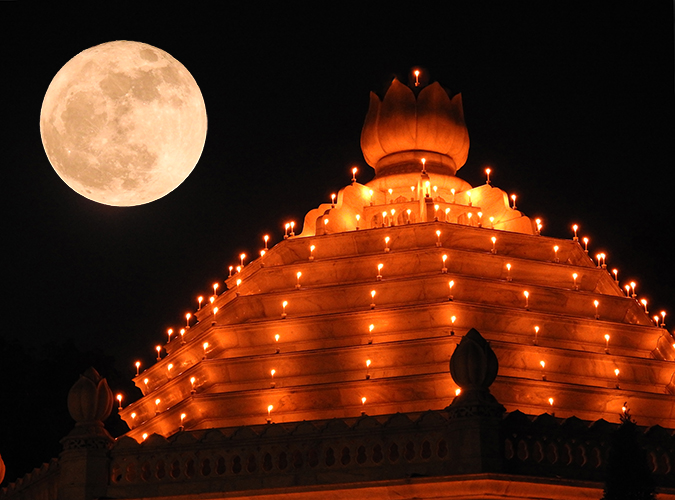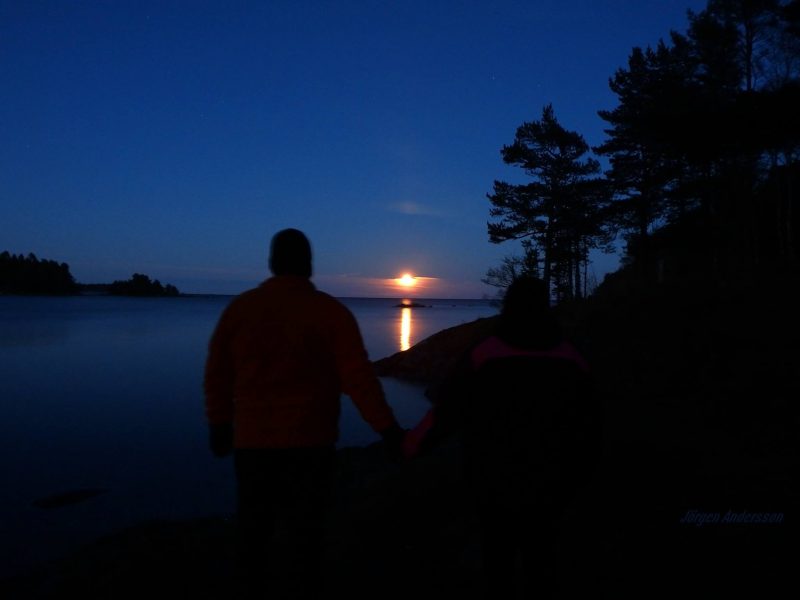
Hunter’s Moon October 20, 2021
In western skylore, the Hunter’s Moon is the full moon after the Harvest Moon. The Hunter’s Moon usually falls in October. If not, it falls in early November. In 2021, on both the evening of October 19 and 20, the moon will be more than 99% lit as it ascends in the east in the evening. October’s full moon – the Northern Hemisphere’s Hunter’s Moon – will be 100% lit on October 20 at 14:56 UTC; translate UTC to your time. On October 21, and even on October 22, you might glimpse a full round moon ascending in the east in early evening. It’s a characteristic of the Hunter’s Moon to rise around the time of sunset for several evenings in a row, as if this month has more than one full moon.
Eastern Australia and New Zealand will see the full moon on October 21. It’s not a Hunter’s Moon for the Southern Hemisphere because it’s spring in that hemisphere now. So the full moon has different characteristics.
Every full moon has a slew of nicknames, and most are tied to months of the year. But some moon names, such as the Harvest and Hunter’s Moons, are tied to seasons. The Harvest Moon is the full moon closest to the September equinox, or autumnal equinox for the Northern Hemisphere. The equinox is typically September 22 or 23. So most Harvest Moons come in September. But, every three years, the Harvest Moon falls in early October and the Hunter’s Moon in November.
In North America, the Harvest Moon was a time when the bright moon meant farmers could stay out later, working in their fields, gathering in the crops before the first freeze. After the harvest, farmers would turn to hunting deer and other animals to bolster their food stores before winter. The light of the full moon would let them hunt into the evening hours. So today we have a Hunter’s Moon.

What makes this moon special?
Nature is particularly cooperative around the time of the autumn equinox to make the fall full moonrises unique. On average, the moon rises about 50 minutes later each day. But when a full moon happens close to the autumnal equinox – either a Harvest or a Hunter’s Moon – the moon (at mid-temperate latitudes) rises only about 30 to 35 minutes later daily for several days before and after the full moon. The reason is that the ecliptic – or the moon’s orbital path – makes a narrow angle with the evening horizon around the time of the autumn equinox.
The result is that there’s a shorter-than-usual lag time between successive moonrises around the full Hunter’s Moon.
Early evening moonrises make every Hunter’s Moon special. Every full moon rises around sunset. After the full Hunter’s Moon, you’ll see the moon ascending in the east relatively soon after sunset for a few days in a row at northerly latitudes.
If you’re in the Northern Hemisphere, look for the moon to be bright and full-looking for several nights from around October 19 to the 22. Around all of these nights, you’ll see a bright round moon ascending in the east in the evening hours.
My favorite source of moonrise times is the Custom Sunrise Sunset Calendar. Once you get to that page, be sure to click the box for “moon phases” and “moonrise and moonset times.”


Is a Hunter’s Moon bigger or brighter?
No. The Hunter’s Moon is just an ordinary full moon with a special path across our sky. Still, many of us do think the Hunter’s Moon looks bigger … or brighter … and more orange than usual. Why?
It’s because the Hunter’s Moon has a powerful mystique. Many people look for it shortly after sunset around the time of full moon. After sunset around any full moon, the moon will always be near the horizon … because full moons rise at sunset. It’s the location of the moon near the horizon that causes the Hunter’s Moon – or any full moon – to look big and orange in color.
Orange moon near the horizon. The orange color of a moon near the horizon is a true physical effect. It stems from the fact that, when you look toward the horizon, you’re looking through a greater thickness of Earth’s atmosphere than when you gaze up and overhead. The atmosphere scatters blue light – that’s why the sky looks blue. The greater thickness of atmosphere in the direction of a horizon scatters blue light most effectively, but it lets red light pass through to your eyes. So a full moon near the horizon – any full moon near the horizon – takes on a yellow or orange or reddish hue.
Big moon near the horizon. The bigger-than-usual size of a moon seen near the horizon is something else entirely. It’s a trick that your eyes are playing – an illusion – called the Moon Illusion.

How did the Hunter’s Moon get its name?
There are many stories surrounding the names of the moons, including the Hunter’s Moon. From a practical standpoint, the Harvest Moon and subsequent Hunter’s Moon provided light in the evenings for farmers and hunters to finish their tasks.
In autumn, the full Harvest Moon and the nearly full moons on the evenings before and after all rise very close to sunset. The sky transitions from sunlight to moonlight without much darkness, so farmers can keep working straight into the evening. A month later, after the harvest ended, the full Hunter’s Moon illuminated prey, scooting along in the stubble left behind in the fields.
Who named the Harvest and Hunter’s Moon? Those names probably sprang to the lips of farmers and hunters throughout the world, on autumn evenings, at times of the full moon.

A note to those in the Southern Hemisphere
If you’re in the Southern Hemisphere, your Harvest and Hunter’s Moons center on the March equinox, your autumn equinox. Much of what we say in his post – the general information about Harvest and Hunter’s Moons – applies to you, too… next March and April. Right now, your full moon will be doing the opposite of a Hunter’s Moon. That is, for the Southern Hemisphere around the time of the September and October full moons, there’s a longer-than-usual time between moonrises on successive nights.

Bottom line: You can find the date and time of the Northern Hemisphere’s full Hunter’s Moon for October 2021, and then learn why this annual moon brightens the evening for a string of days.
The post The full Hunter’s Moon is October 20 first appeared on EarthSky.
0 Commentaires